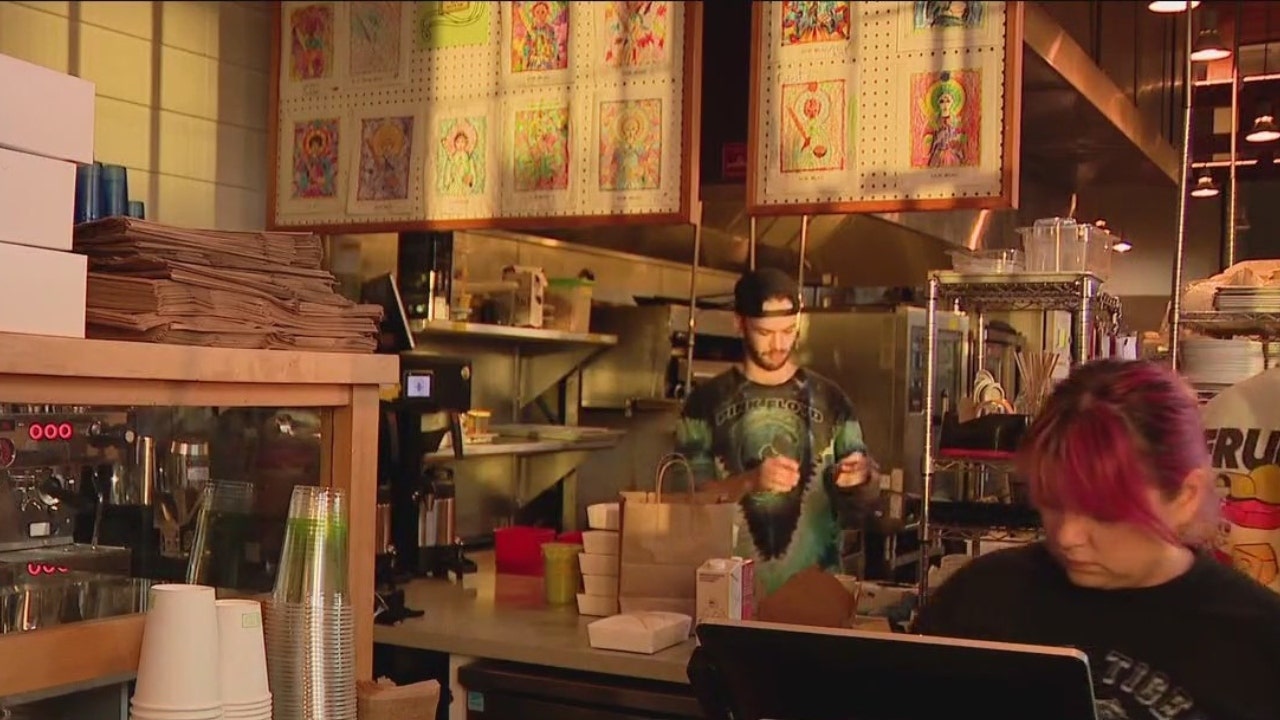Illinois
Child social media stars have few protections. Illinois aims to fix that

CHICAGO (AP) — Holed up at home during the pandemic lockdown three years ago, 13-year-old Shreya Nallamothu was scrolling through social media when she noticed a pattern: Children even younger than her were the stars — dancing, cracking one-liners and being generally adorable.
“It seemed innocuous to me at first,” Nallamothu said.
But as she watched more and more posts of kids pushing products or their mishaps going viral, she started to wonder: Who is looking out for them?
“I realized that there’s a lot of exploitation that can happen within the world of ‘kidfluencing,’” said Nallamothu, referring to the monetization of social media content featuring children. “And I realized that there was absolutely zero legislation in place to protect them.”
Illinois lawmakers aim to change that by making their state what they say will be the first in the country to create protections for child social media influencers. Nallamothu, now 15, raised her concerns to Illinois state Sen. David Koehler of Peoria, who then set the legislation in motion.
The Illinois bill would entitle child influencers under the age of 16 to a percentage of earnings based on how often they appear on video blogs or online content that generates at least 10 cents per view. To qualify, the content must be created in Illinois, and kids would have to be featured in at least 30% of the content in a 30-day-period.
Video bloggers — or vloggers — would be responsible for maintaining records of kids’ appearances and must set aside gross earnings for the child in a trust account for when they turn 18, otherwise the child can sue.
The bill passed the state Senate unanimously in March, and is scheduled to be considered by the House this week. If it wins approval, the bill will go back to the Senate for a final vote before it makes its way to Gov. J.B. Pritzker, who said he intends to sign it in the coming months.
Family-style vlogs can feature children as early as birth and recount milestones and family events — the wholesome clips that Nallamothu had been initially scrolling through.
But experts say the commercialized “ sharenthood ” industry, which can earn content creators tens of thousands of dollars per brand deal, is underregulated and can even cause harm.
“As we see influencers and content creators becoming more and more of a viable career path for young people, we have to remember that this is a place where the law has not caught up to practice,” said Jessica Maddox, a University of Alabama professor who studies social media platforms.
She added that child influencers “are in desperate need of the same protections that have been afforded to other child workers and entertainers.”
The Illinois bill is modeled largely after California’s 1939 Jackie Coogan law, named for the silent film-era child actor who sued his parents for squandering his earnings. Coogan laws now exist in several states and require parents to set aside a portion of child entertainers’ earnings for when they reach adulthood.
Other states have tried to pass laws to regulate against potential child exploitation on social media without success. A 2018 California child labor bill included a social media advertising provision that was removed by the time it was passed, and Washington’s 2023 bill stalled in committee.
Across the Atlantic, France passed a law in 2020 that entitles child influencers under 16 to a portion of their revenue, as well as “the right to forget,” which means video platforms must withdraw the images of the child at the minor’s request. Parental consent is not needed.
Illinois’ own bill underwent several changes during the legislative session that watered down its reach, including stripping out a provision allowing child influencers to request deletion of content once they reached the age of 18, and requiring family vloggers to register their channels.
Still, Chicago-based Tyler Diers, the Midwest executive director of technology trade association Technet, which opposed the bill before the changes but is now neutral, said that when one state legislature takes up an issue, others tend to follow, “and oftentimes perfect what the first state did.”
Nallamothu emphasized that the Illinois bill isn’t aimed at “parents posting their kids on Facebook for their close family and friends,” or even a funny clip that went viral.
“This is for families who make their income off of child vlogging and family vlogging,” she said.
Many social media platforms — including Facebook, Instagram and TikTok — don’t allow children to have accounts until they’re at least 13 years old. But that hasn’t stopped them from appearing on social media. And the internet is littered with examples of children being showcased for financial gain — and the harm it has caused as a consequence.
In 2019, an Arizona mother was accused of torturing her seven adopted children for subpar performances in their popular YouTube series, Fantastic Adventures; a Maryland couple who posted “prank” videos of themselves screaming at their children and breaking their toys lost custody and were sentenced to five years of probation for child neglect.
Another YouTube couple filmed every step of their family’s process of adopting a young child from China with autism, only to eventually place him in a new home.
Chris McCarty, an 18-year-old college student who founded Quit Clicking Kids, an advocacy organization focused on protecting minors being monetized online, and who was the force behind the bill in Washington, noted that “this issue is not going away.”
“Once these kids start growing up, the true extent of the damage inflicted by monetized family channels will be realized,” McCarty said at a hearing for the Washington bill in February.
TikToker Bobbi Althoff is the mother of two little girls she lovingly refers to as “Richard” and “Concrete” to her 3.7 million followers. Althoff used to share her older daughter’s face and real name online, but stopped after people made rude comments about her.
“I kept thinking about my daughter growing up to read these things, and it really upset me because I hate reading things like that about myself,” she said.
When she shared her decision on Instagram, she lost thousands of followers and received backlash.
“A lot of people were supportive, but there were definitely a lot of people that were very strange about it,” Althoff said, describing how some viewers seemed to feel like “they had a relationship with my daughter… and wanted to keep seeing her grow.”
Although TikTok-famous tots are not quite old enough to reflect on their experiences, child reality TV stars of the last decade can offer comparable insight on how it feels to be on the other side of the camera.
Ohio-based Jason Welage enjoyed his time as a preteen on TruTV’s 2015 reality show Kart Life, which followed families in the world of go-kart racing. Now 20, Welage says some of the less pleasant aspects have followed him into adulthood.
“When you Google the show, the first clip that comes up on YouTube is me coming off the track and crying,” he said. “I still hear about it to this day.”
His parents funneled the $10,000 he earned on the show back into his racing, which can cost families up to $150,000 a year, according to his mother, Meghan, who, like her son, supports the child influencer legislation in Illinois and hopes similar laws will be implemented in other states or even federally.
For children appearing on social media or TV, “it’s definitely work for them,” she said. Her son “wanted to go play, but instead he had to go sit on a stool in our motorhome and do interviews.”
“There should be something to compensate the child for what they are going through or what they have to do,” she said.
___
AP Staff Writer Elaine Ganley in Paris contributed to this report.
___
Savage is a corps member for the Associated Press/Report for America Statehouse News Initiative. Report for America is a nonprofit national service program that places journalists in local newsrooms to report on undercovered issues.

Illinois
Why Illinois Basketball Is Strangely Sinking in KenPom Rankings

About two weeks ago, Illinois was fresh off a bounce-back win over then-No. 20 Wisconsin and sitting at 7-2 (1-1 Big Ten).
Even considering the previous Friday’s overtime loss to Northwestern – which hadn’t won a high-major game at that point – and the fact that Illinois had dropped out of the AP Top 25 poll, the Illini were still well-respected by the metrics, landing at No. 15 in the KenPom rankings.
Fast forward to present day, after the Illini have played two more games. A heart-breaking two-point home loss to No. 1 Tennessee and a commendable 80-77 neutral-site win over a 10-2 Missouri squad in St. Louis.
Still braggin’ 🏆#Illini | #HTTO | #EveryDayGuys pic.twitter.com/jS70685xfF
— Illinois Men’s Basketball (@IlliniMBB) December 22, 2024
Naturally, one would think 40 competitive minutes against the top team in the country and a victory over a high-quality SEC team (especially in a rivalry game) would boost not only Illinois’ reputation but also its standing in metrics such as KenPom.
Actually, the opposite was the case.
In fact, Illinois dropped all the way to No. 23 – no longer even among the top five in the Big Ten (Maryland, Oregon, Michigan State, UCLA, and Michigan are all ranked above).
Even more surprising, this came during a time when the Illini’s defensive efficiency actually climbed, from 17th all the way up to 11th over the past two weeks.
The issue, as has been the case all season, lies on the other end of the floor.
Over that two-week stretch, Illinois’ offensive efficiency has fallen from 25th to 37th. Given that KenPom’s metrics use a combination of data from the box score and play-by-play, it’s likely that Illinois’ KenPom offensive efficiency has continued to falter due to its combined 40-for-108 shooting (37.0 percent) against Tennessee and Missouri.
It’s important to note that it is only late December and Illinois has played just two conference games, which means two things: 1) KenPom isn’t working with a great deal of data just yet, and 2) the Illini will get a boatload of opportunities to prove themselves moving forward.
And those opportunities are coming sooner rather than later, as Illinois gets its last tune-up game of the season against Chicago State on Sunday before diving head-first into conference play and kicking the New Year off with a matchup against No. 9 Oregon in Eugene on January 2.
3 Big Takeaways From Illinois Basketball’s Rivalry Win Against Missouri
Illinois Basketball Outlasts Missouri to Win a Braggin’ Rights Banger
Illinois Basketball Report Card: Grades vs. Missouri (Game 11)
Illinois
Duplex in Springfield sells for $1.1 million

A 1,710-square-foot two-unit house built in 1969 has changed hands. The property located at 57 East Bay Path Terrace in Springfield was sold on Dec. 6, 2024. The $1,100,000 purchase price works out to $643 per square foot. This two-story duplex presents a total of four bedrooms and two bathrooms. The interior features just one fireplace. The property sits on a 5,022-square-foot lot.
Additional houses have recently been sold nearby:
- In December 2023, a 1,710-square-foot home on Humbert Street in Springfield sold for $318,000, a price per square foot of $186. The home has 4 bedrooms and 2 bathrooms.
- On Cloran Street, Springfield, in December 2021, a 1,710-square-foot home was sold for $310,000, a price per square foot of $181. The home has 4 bedrooms and 2 bathrooms.
- A 1,920-square-foot home at 37-39 Nathaniel Street in Springfield sold in January 2023, for $249,900, a price per square foot of $130. The home has 4 bedrooms and 2 bathrooms.
Real Estate Newswire is a service provided by United Robots, which uses machine learning to generate analysis of data from Propmix, an aggregator of national real-estate data. See more Real Estate News
Illinois
‘It’s a blessing’: Springfield Christmas dinner serves nearly 600

SPRINGFIELD — Edwin DeJesus was showing his holiday spirit on his sleeve, and his pants, as he and his mom tucked into a roast beef dinner at the High School of Commerce Christmas Day.
“It is a blessing,” DeJesus said, wearing a green shirt showing Snoopy’s doghouse decorated with Christmas lights, green Dr. Seuss’ Grinch pants and a bright red hat.
-
/cdn.vox-cdn.com/uploads/chorus_asset/file/24924653/236780_Google_AntiTrust_Trial_Custom_Art_CVirginia__0003_1.png)
/cdn.vox-cdn.com/uploads/chorus_asset/file/24924653/236780_Google_AntiTrust_Trial_Custom_Art_CVirginia__0003_1.png) Technology5 days ago
Technology5 days agoGoogle’s counteroffer to the government trying to break it up is unbundling Android apps
-

 News6 days ago
News6 days agoNovo Nordisk shares tumble as weight-loss drug trial data disappoints
-

 Politics6 days ago
Politics6 days agoIllegal immigrant sexually abused child in the U.S. after being removed from the country five times
-

 Entertainment7 days ago
Entertainment7 days ago'It's a little holiday gift': Inside the Weeknd's free Santa Monica show for his biggest fans
-

 Lifestyle7 days ago
Lifestyle7 days agoThink you can't dance? Get up and try these tips in our comic. We dare you!
-

 Technology1 week ago
Technology1 week agoFox News AI Newsletter: OpenAI responds to Elon Musk's lawsuit
-
/cdn.vox-cdn.com/uploads/chorus_asset/file/25672934/Metaphor_Key_Art_Horizontal.png)
/cdn.vox-cdn.com/uploads/chorus_asset/file/25672934/Metaphor_Key_Art_Horizontal.png) Technology2 days ago
Technology2 days agoThere’s a reason Metaphor: ReFantanzio’s battle music sounds as cool as it does
-

 News3 days ago
News3 days agoFrance’s new premier selects Eric Lombard as finance minister



















